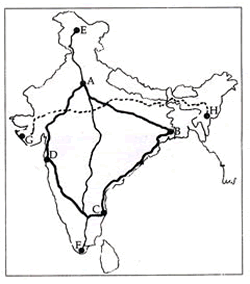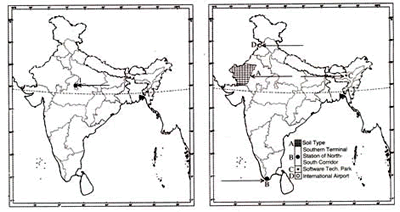Q.1. Describe the contribution of Jyotiba Phule in the field of social reform. (2)
Q.2. Explain the importance of the Sangam Literature in the history of Southern India. (2)
Q.3. What was the influence of India’s past discovery on the national awakening? (2)
Q.4. Mention the names of the two groups of Bhakti saints of South India. (2 x 1 = 2)
Q.5. Study the given map, showing the express way national highway development project and answer the questions that follow: (1 + 1 = 2)

(5.1) Name the express way national highway that will join stations E and F.
(5.2) Give the proper term used for the express way national highway connecting stations A, B, C and D.
Q.6. How is afforestation helpful in maintaining ecological balance? Give two points. (2 x 1 = 2)
Q.7. Name any four means of communication. (4 x ½ = 2)
Q.8. What are the two bases of measuring the economic development of a country? (2 x 1 = 2)
Q.9. Give two arguments in favour of regulating the prices in India. (2 x 1 = 2)
Q.10. Give two examples to prove that social development has become a global phenomenon. (2 x 1 = 2)
Q.11. Explain any two measures to protect buildings against the floods in India. (2 x 1 = 2)
Q.12. Explain any two main objectives of search and rescue team in disaster management. (2 x 1 = 2)
Q.13. Critically examine the reasons for starting Swadeshi and Boycott movements, with its main features. (2 + 2 = 4)
Or
Examine critically the main provisions of the Morley-Minto Reforms (1909). What was its effect on the Freedom movement?
Q.14. Explain any four ways through which Indian agricultural products can compete in the world market in context to Globalization. (4 x 1 = 4)
Or
Explain any four Technological and Institutional Reforms made in Indian agriculture after Independence.
Q.15. What are the four types of coal? Write one main characteristic of each. (2 + 2 = 4)
Q.16. Explain how industrial pollution degrades the environment. (4)
Q.17. Explain any four steps taken by the Government to control price rise. (4 x 1 = 4)
Q.18. Explain any four causes of poverty in India. (4 x 1 = 4)
Or
Explain the term ‘World Labour Market’. Mention two reasons responsible for the ‘brain drain’ from India. (2 + 2 = 4)
Q.19. Explain India’s role in the promotion of world peace. (4)
Q.20. What is tsunami? Write two preparedness measures taken before, during and post tsunami scenario. (1 + 1 + 1 + 1 = 4)
Q.21. Examine the main demands and achievements of the Indian National Congress from 1885 to 1905. (6)
Or
Evaluate the significance of the Quit India Movement in the freedom struggle of India.
Q.22. How does casteism and untouchability hamper democratic process in India? Suggest two measures for the eradication of casteism.( 4 + 2 = 6)
Or
Explain any three concessions which have been provided to the weaker sections of society for adequate representation in Government service. (3 x 2 = 6)
Q.23. What is land degradation? Describe any five measures of controlling land degradation. (1 + 5 = 6)
Or
Describe any six measures adopted for the conservation of water resources.
Q.24.
Or
On the given political outline map of India (24 b) locate and label the following:
